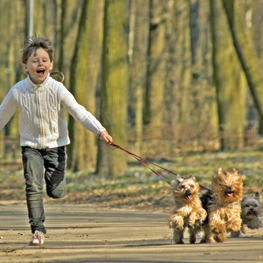We want our children to develop self-reliance and independence, yet if we are not mindful in our parenting, we may hinder their ability to do so. Frequently we do too much, we fail to step aside or we overprotect and hover in the name of love.
 For autonomy to develop, parents must be intentional about providing opportunities. As children gain experience and successfully (or unsuccessfully) practice independence, they learn personal responsibility. They figure out how to negotiate bumps in the road, bullies, stressful circumstances and everyday frustrations. They make mistakes. They grow up better equipped to tackle grown-up life.
For autonomy to develop, parents must be intentional about providing opportunities. As children gain experience and successfully (or unsuccessfully) practice independence, they learn personal responsibility. They figure out how to negotiate bumps in the road, bullies, stressful circumstances and everyday frustrations. They make mistakes. They grow up better equipped to tackle grown-up life.
Early childhood autonomy builders
Founder of The Conscious Parenting Alliance, expert Shelly Birger Phillips believes autonomy-building can begin simply with a home inventory. She suggests the following tips to help preschool-aged kids develop a sense of autonomy at home:
1. Do kids have an easily-accessible place to put their coats and shoes when they get home? (The easiest place to put a coat is on a low hook near the front or back door.)
2. Is there a place (such as a kid-sized bench) for putting shoes on and off?
3. Can toys and books be reached in the living room?
4. Are they able to access art supplies, dishes, water and snacks in the kitchen?
5. Is there a stool in the bathroom that makes using the toilet and washing hands easy? Can they reach the towel to dry their hands?
6. Is there easy access to drinking water?
7. A child’s bedroom should be the most accessible and easy to navigate. Your child should be able to access clothes, a hamper, full length mirror for grooming, toys, books, games and other supplies they enjoy.
8. For toy storage, small bins containing a few items each provide easier to access than huge overfilled bins.
9. Your child should have a reading chair that fits their body.
10. Your child should be taught practical life skills such as pouring, spooning, cutting and cleaning up.
Autonomy builders for older children
It is likely that these ideas for increasing independence are already a part of your parenting repertoire. However, it never hurts to take stock. Embrace the Future is an organization in Australia working with teachers, families and schools to increase resiliency in children. The program suggests these tips to promote an older child’s autonomy:
1. Encourage age-appropriate responsibilities, such as caring for a pet.
2. Help them think up their own solutions to problems rather than solving for them.
3. Expect them to rise to small challenges, like making a phone call for themselves.
4. Encourage them to make their own choices.
5. Model and teach good coping skills for coping with stress:
Avoid overprotecting
Author Nadine Descheaux writes, “Parents often tend to do things for their children in order to help them, to hurry things up or because they are under the misconception that their child will not be able to accomplish the task alone.” Descheaux identifies attitudes and behaviors, which may be detrimental to the development of autonomy:
Bear in mind, children make many mistakes on the road to developing autonomy. Parents must also be mindful of how to respond when these wrinkles happen.
Author of Raising Children Who Can Think for Themselves (2001), Dr. Elisa Medhus reminds us “to never nag, threaten or label when they don’t come through on their responsibilities” and to be sure to remark when they do so successfully.
Michele Ranard, M.Ed., has a husband, two children and a master’s in counseling.
Calgary’s Child Magazine © 2024 Calgary’s Child